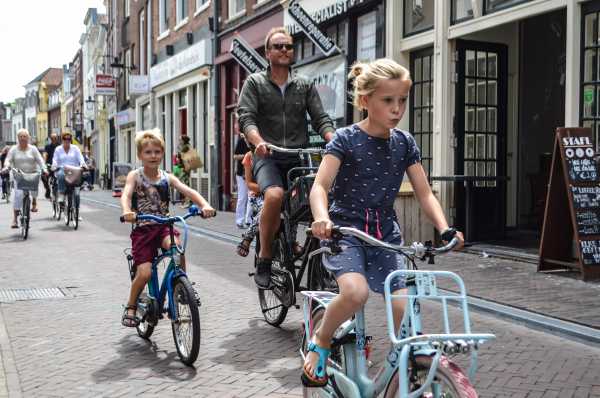
In 2010, Chris and Melissa Bruntlett sold their cars and began transporting their family of four around Vancouver, BC, by bike. They noticed that bicyclists’ stories were not being told, so they started blogging about their carless lifestyle at the website of what would become their creative agency, Modacity.
Through cycling circles, they heard stories and saw pictures of cycling in Dutch cities, so they went to the Netherlands to check it out, visiting five cities to study cycling infrastructure, talk with local leaders, and share pictures, videos, and articles.
They ended up gathering enough material for a book, which was released Tuesday from Island Press: Building the Cycling City: The Dutch Blueprint for Urban Vitality. It’s a tour of Dutch bicycling culture that attempts to extract lessons that can be applied to other cities, including, yes, American cities.
I chatted with the Bruntletts by phone earlier this month about everything from how the Dutch have taken the concept of the protected bike lane and applied it to the intersection to the amazing Dutch cycling skills courses for kids. We even covered why the right wing in the Netherlands has to support more spending on cycling. Our conversation has been edited for length and clarity.
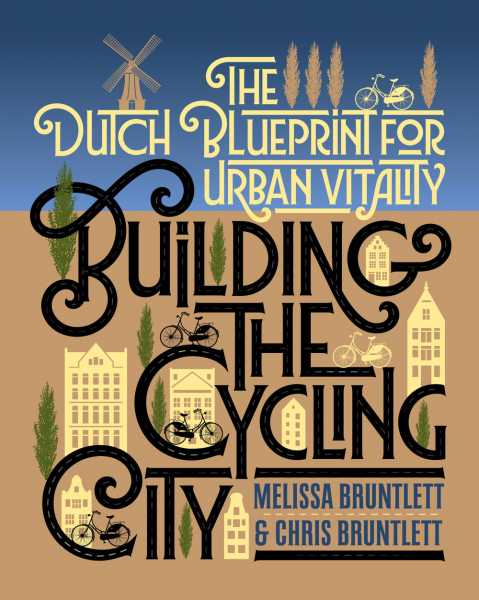
David Roberts
The American stereotype of the Netherlands is that they’ve got it all figured out; they do everything right. But your book makes it clear that everybody was not always on the same page. There were political battles.
Chris Bruntlett
One of the things we heard repeatedly when we got back was, “That would never work here, our city’s different.” We would always say, “well, every Dutch city is different!”
Rotterdam, for example, was completely obliterated during the Second World War and rebuilt in this post-war, modernist image — designing cities around the automobile, where people would live outside the city, commute by car into the city every day, and everyone would have more light and space and air. They’d be living happily in the suburbs.
It didn’t take long for Rotterdammers to realize this wasn’t the future they wanted. The spaces they were building were inhospitable to walking and cycling and public transit. Cycling rates were plummeting. There were more road fatalities.
So, not just in Rotterdam, but in cities across the Netherlands in the ’70s, there was a real rejection of this car-centric urban planning.
Some of them resisted better than others. In Rotterdam, they managed to reverse the tide and retrofit some of these spaces for other modes of transportation. But certainly a lot of Dutch cities made mistakes. In Utrecht, they paved over canals. In Amsterdam, they came just a single city council vote away from demolishing the Jewish quarter of their city to build a four-lane motorway.
So their status as a cycling nation wasn’t always a given. It took a lot of hard work, a certain degree of stubbornness, and forward-thinking politicians to get where they are. And even then, you know, the margins were really, really tight.
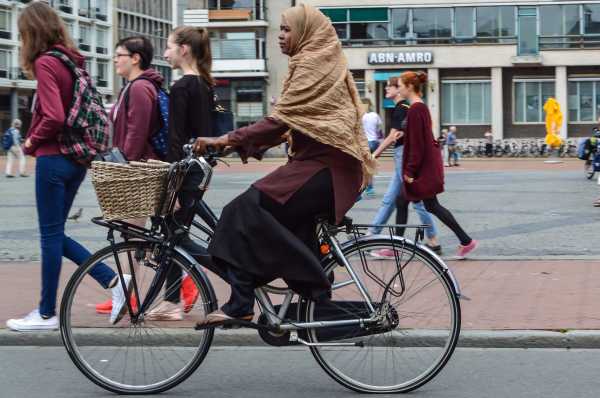
David Roberts
The Dutch have this distinction between two kinds of cyclists that I thought was interesting.
Melissa Bruntlett
The Dutch have wielrenners, or “wheel runners” — the sporty cyclists — and they have a fietser, which is just “someone on a bike.” When you talk to somebody in the Netherlands about what makes biking so special, most of them will say, “What are you even talking about? It’s no different than when I get on the train or go for a walk.” You’re no more a cyclist than you are a pedestrian or a driver or a public transit user.
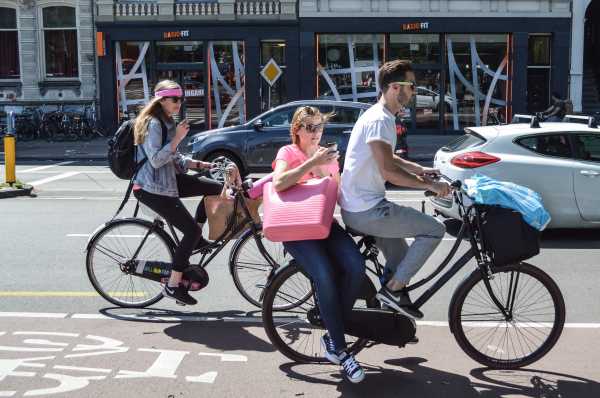
David Roberts
In terms of bike infrastructure, I think most people in the US are primarily familiar with painted strips on the side of the road, those little “sharrows.” What are the practical elements of infrastructure that make it safe for, say, an elderly fietser to go out biking in the Netherlands?
Chris Bruntlett
This is a critical point: The Dutch built environment treats people who ride bikes normally, everyday fietsers, with respect and dignity and gives them a wholly separate space to cycle.
So the Dutch design manual classifies roads depending on the speed of the cars traveling in them. If there’s any major difference in speed, then full separation is required — concrete barriers, a grass median, planter boxes, or bollards.
David Roberts
What is the speed threshold?
Chris Bruntlett
Anything where cars are traveling faster than 30 kph. So, what’s that, 19 mph?
Mixing is permitted on streets where the cars are traveling slower than that. But the volume of cars needs to be fairly low, so that the cyclist still feels comfortable traveling on those streets.
Melissa Bruntlett
In those shared spaces, it’s usually cobblestone, or raised crosswalks, speed bumps where they’re needed. It’s very clearly delineated that cars are guests in these spaces.
Cycle tracks are all paved with this easily identified red pavement, an inch-thick top coat of dyed red asphalt. It’s everywhere throughout the Netherlands — you know when you’re on a cycle track.
They’ll do raised cycle tracks when speeds don’t go above 50 kph (30 mph), and then on highways or motorways, it will be an adjacent pathway, again with that trademark red, but completely separated.
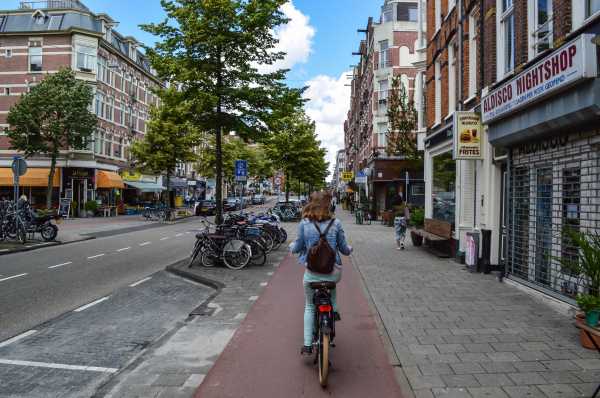
David Roberts
Say a little bit about intersections. I’m morbidly interested in intersections.
Chris Bruntlett
It’s one area we criminally underlook in North America. We build these protected bike lanes (if they’re protected at all) and then in an intersection you’re stuck in no man’s land. That’s where the vast majority of collisions occur.
The Dutch have taken the concept of the protected bike lane and carried it through the intersection. More often than not, there is physical protection on the corners where there’s cars turning right or left. There’s often mid-block protection provided as well, so that you don’t feel exposed. The raised cycle track is also carried through the intersection. Through design, they’ve made the cycle track a priority — visually and physically.
The cars know that they are to look out for bikes. They are treated almost as guests in the city, which is a complete 180 from how we function here in North America.
David Roberts
And you write that there are all-way, no-signs intersections?
Melissa Bruntlett
One of the things they started testing in the city of Groningen — which is in the north, and has some of the highest rates of cycling in the entire country — is having intersections where the cars have to wait and there’s a bicycle-only signal. You have bikes turning in six different directions, all moving at the same time, from every corner.
It sounds completely counterintuitive, but when we experienced it, it’s really just a matter of making eye contact. Everything is done through visual clues. We traveled through that intersection easily a dozen times during our trip there, with our children, and never once experienced any sort of collision. Maybe a couple of frustrated Dutch people because we were riding too slowly!
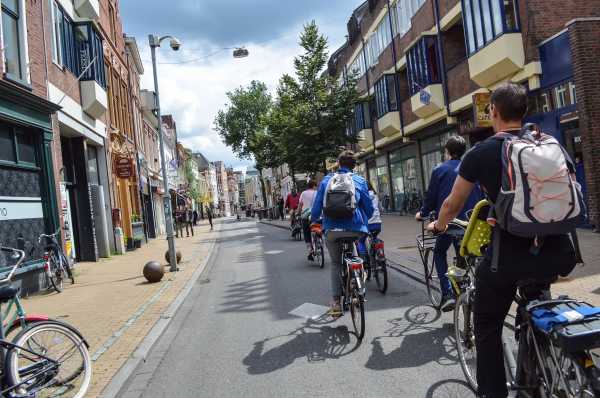
David Roberts
I taught my kids to ride bikes, but there’s no real system set up for them to get education in it, and not that many safe places to ride. What do Dutch kids experience early on, in terms of bikes?
Melissa Bruntlett
The concept of cycling starts getting introduced to a lot of kids in preschool. They’ll run around on these push bikes. But the biggest education — while it’s not mandatory throughout the country, it’s done by most schools — is students around grade four or five, in the 10 and 11 age range, start taking cycling skills courses.
Between the ages of 11 and 12 they have to take a written exam to show that they understand the rules of the road. They also do a practical exam. So, every year, dozens or hundreds of Dutch students go out onto the street and travel on their routes to get to school, on a designated pathway. The Fietsersbond, which is their national cycling advocacy group, puts the kids right in real life situations, navigating their streets, knowing when to turn, how to signal, where to stop.
After they complete this practical exam, they get a certificate saying, “I successfully passed the cycling skills program and can now responsibly ride through my city on my own.” It’s kinda neat.
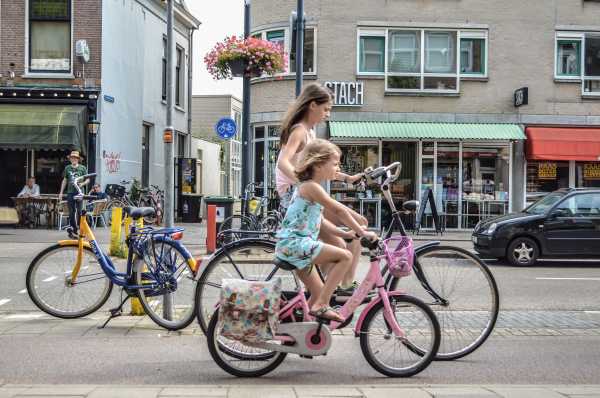
David Roberts
How do bikes fit in with public transit in the Netherlands?
Chris Bruntlett
As Marco te Brömmelstroet, a professor at the University of Amsterdam, explained to us, the bike alone doesn’t replace the private automobile, and neither does public transit, but when you combine the two, that’s when the magic happens. Then the car becomes redundant in cities.
The Dutch use bikes as a tool to feed their transit system: 50 percent of all trips that take place on the transit system in the Netherlands begin with a bicycle ride.
It serves two goals. It increases the size of the catchment area for each station, so it’s feeding more customers into the public transit system. And it gives people a variety of options; they’re not dependent on one particular trip.
It’s creating this virtuous circle of sustainable transportation, where they have more people riding transit because the infrastructure is built to reach the stations. Cycling plays an important first-mile, last-mile role on these longer trips that may be 10, 15, 20 kilometers. That’s where you see replacement of car trips in cities: by capturing those mid-to-long trips.
Melissa Bruntlett
And they’ve also introduced the OV-Fiets, a rental bike, which is providing the last-mile solution. So 50 percent of people are coming to the station with their bike. They take their train, and on the other end, historically, they didn’t have anything to get them from the station to their next point of destination.
Now anyone who has their OV-chipkaart — the transit tap card they use for bus, trains, trams, and these OV-Fiets bikes — can pick up a bike from the train station, for €3.50 for every 24-hour period. They can have that bike all day, take it back to the train station, get on a train, and go back home to their other bike, all in one seamless trip.
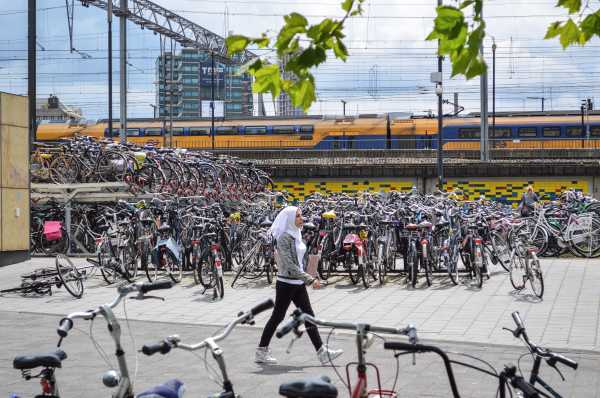
The National Rail [NV Nederlandse Spoorwegen] and ProRail, which are the two organizations managing this, have found in surveys that it’s actually replacing car trips, because people have an option at the other end. Unfortunately, they’ve been victims of their own success and can’t seem to keep up with the demand. They never have enough bikes!
David Roberts
Did you see one of those giant automated bike garages the Dutch are famous for?
Chris Bruntlett
One of the more spectacular products of this bike-train system is this sea of bicycles you see at any train station in the Netherlands. Step out of Amsterdam’s Grand Central — they had to build [a bike garage] over the canal because of the thousands and thousands of people that cycle to the train station every day.
Because of Utrecht’s size and location in the country, it is ground zero for this bike-train connection. They’re in the process of building something like 30,000 bike parking spots in the next 10 years. One such facility is 12,500 spaces. When it opens, either late this year or early next year, it will be the biggest bike-parking facility in the world.
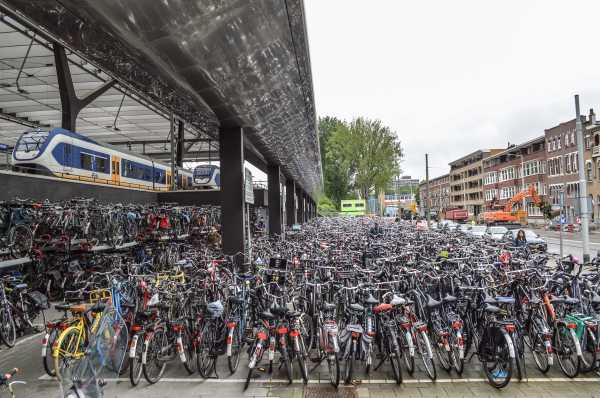
David Roberts
In the book, you stress the difference in Dutch bikes themselves. How are they different from US bikes?
Melissa Bruntlett
The first thing is, when the Dutch go into a shop to buy a bike, they’re buying a complete bicycle. Oftentimes in North America when we go into a bike shop, there’s a bike, but there’s no fenders, lights, racks, kickstand, bell, any of that kind of stuff. In the Netherlands, they don’t sell incomplete bikes because they need it to be practical.
There, everyone, save maybe a small percentage of the population, rides these Dutch-style bikes, as they’ve come to be known (even though their origins are in England). You’re seated in an upright position, almost like you’re sitting on a stool or a chair. You’re forced to interact with people, because you can see them clearly. It just helps to breed that relaxed way of cycling. They don’t have to stress about looking up every time they have to turn. Signaling is a breeze. They’re largely single speed.
Chris Bruntlett
We make a differentiation between the hunched-and-helmeted cyclist and the upright, bare-headed cyclist. Upright, everyday cycling, a form of walking-with-wheels, is far more broad, inclusive, accessible, and appealing to people of all ages and fitness levels. It isn’t just about getting from A to B as quickly as possible, it’s about enjoying the ride.
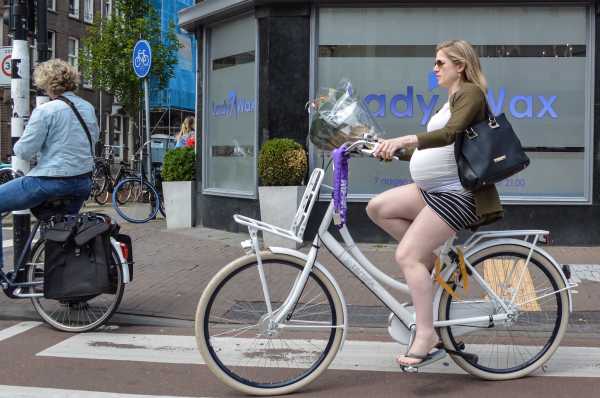
David Roberts
In US cycling culture, bikes themselves — the materials, the brands — are often somewhat fetishized. Is that true in the Netherlands?
Melissa Bruntlett
Not at all. Most of them will ride their bike until it falls apart. Their bikes are meant to be workhorses to last through all seasons, all kinds of beatings, because they live out on the street.
Most people we met still have their road bike that is lightweight, super-fast, clipped shoes, and all that, but that’s their weekend bike, when they go out and go for long rides, for sport and fitness. But the everyday bike, I mean, the image that most people have is of this black, beat up, vintage-looking Dutch bike — and that is literally what most of them ride around.
David Roberts
The Dutch don’t wear bike helmets. How safe is it to ride a bike in the Netherlands?
Chris Bruntlett
We — like you — live in a place where helmets have been mandated by law, because they’ve been accepted as a commonsense safety device, normal as a seatbelt. But the Dutch show that [for them], safety in infrastructure, safety in slowing cars, and safety in numbers are all far more important than safety in body armor.
David Roberts
Yeah, the US approach seems to be to up-armor the cyclist so that cars don’t have to change.
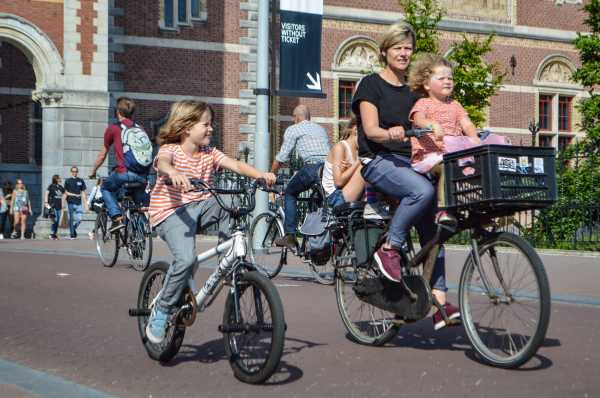
Chris Bruntlett
Exactly.
Less than 0.5 percent of Dutch cyclists wear helmets, which is one in 200 people on bikes. And that’s really just the sport cyclists. Virtually everybody else, from children to old people, doesn’t even think about helmets. It’s just not present in their culture, because they’ve ultimately decided that it’s far more important to build this culture of everyday cycling, and to build safe streets, instead of requiring people to protect themselves.
David Roberts
The Netherlands seems to be getting serious about long-distance bike corridors — bike highways. Are those getting used?
Melissa Bruntlett
For sure.
For decades, the Dutch have had a country-wide network of bicycle trails. You can get from one city to another on a bike, no matter the distance. You could travel the whole country by bike if you wanted to.
But what they started to realize in recent years is that, while that infrastructure exists, it isn’t very well-connected. So now they’re trying to find ways to make it a viable transportation option, an alternative to taking the motorway between two cities.
The greatest opportunity these are providing is for people in the growing e-bike market. You can travel further without having to break a sweat, and get from city to city on a very convenient, continuous path.
The one we talk about in the book is the RijnWaalpad, which connects the city of Arnhem with the city of Nijmegen, about 14 to 15 kilometers. At no point on that trip do you ever have to put your foot down. You ride continuously, uninterrupted.
David Roberts
How are e-bikes and electric scooters and electric mopeds fitting into Dutch bike culture?
Chris Bruntlett
The thing the Dutch have done well is classify these electric vehicles. Again, it comes down to the speed they’re capable of traveling. Regular e-bikes are speed-limited to [19 mph]. As long as you don’t exceed that speed, you’re able to use the regular bike infrastructure.
If the bike is capable of going faster than that, it must utilize the streets and act like a car. There’s insurance requirements, licensing requirements, helmet mandates for those machines.
With the e-bike and electromobility in general, they’ve shown in the Netherlands, that they’re getting people to make better choices around personal transportation. They’re more likely to take their e-bike or scooter than an Uber or a taxi, or even the public transit system.
That little electric boost provides additional psychological help, and to encourage them to ride longer distances. So we are champions of electromobility, within reason. Cities still need to carefully regulate and react to the changes — I don’t think anybody foresaw, for example, the scooter disruption that’s happened on our streets.
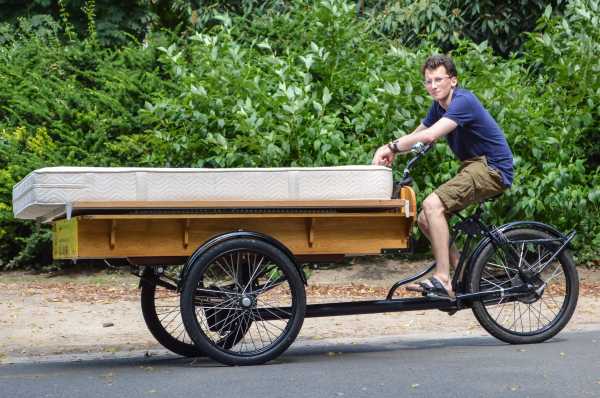
David Roberts
Some US cities have had to deal with an anti-bike lobby. Does that kind of sentiment or political force even exist at all in the Netherlands any more? Is there anyone pushing back?
Chris Bruntlett
Not that I’m aware. We had conversations with politicians there and they made it perfectly clear: Even the right-wing in the Netherlands has to support more spending on cycling.
David Roberts
Because of public pressure, public opinion?
Chris Bruntlett
Exactly. It’s not a tenable or realistic position to win an election when probably 80 percent of the population cycles at least once a week.
That’s not to say they aren’t also undermining the cause by building car parking and the like.
David Roberts
So, pro-bike is settled, but anti-car maybe is not?
Chris Bruntlett
The Dutch still love their cars. They drive miles and miles, as much as neighboring countries. They’re having the same conversations as we are around the allocation of space, because they built all this space for cycling and it started to fill up. Now they’re trying to push for more space for cycling, and the exact same argument is being made, around loss of parking, loss of vehicle lanes. Here, we’re just arguing for any space,
David Roberts
So it never ends? Every bit you take away from cars is a battle, forever?
Chris Bruntlett
Exactly.
Sourse: vox.com






